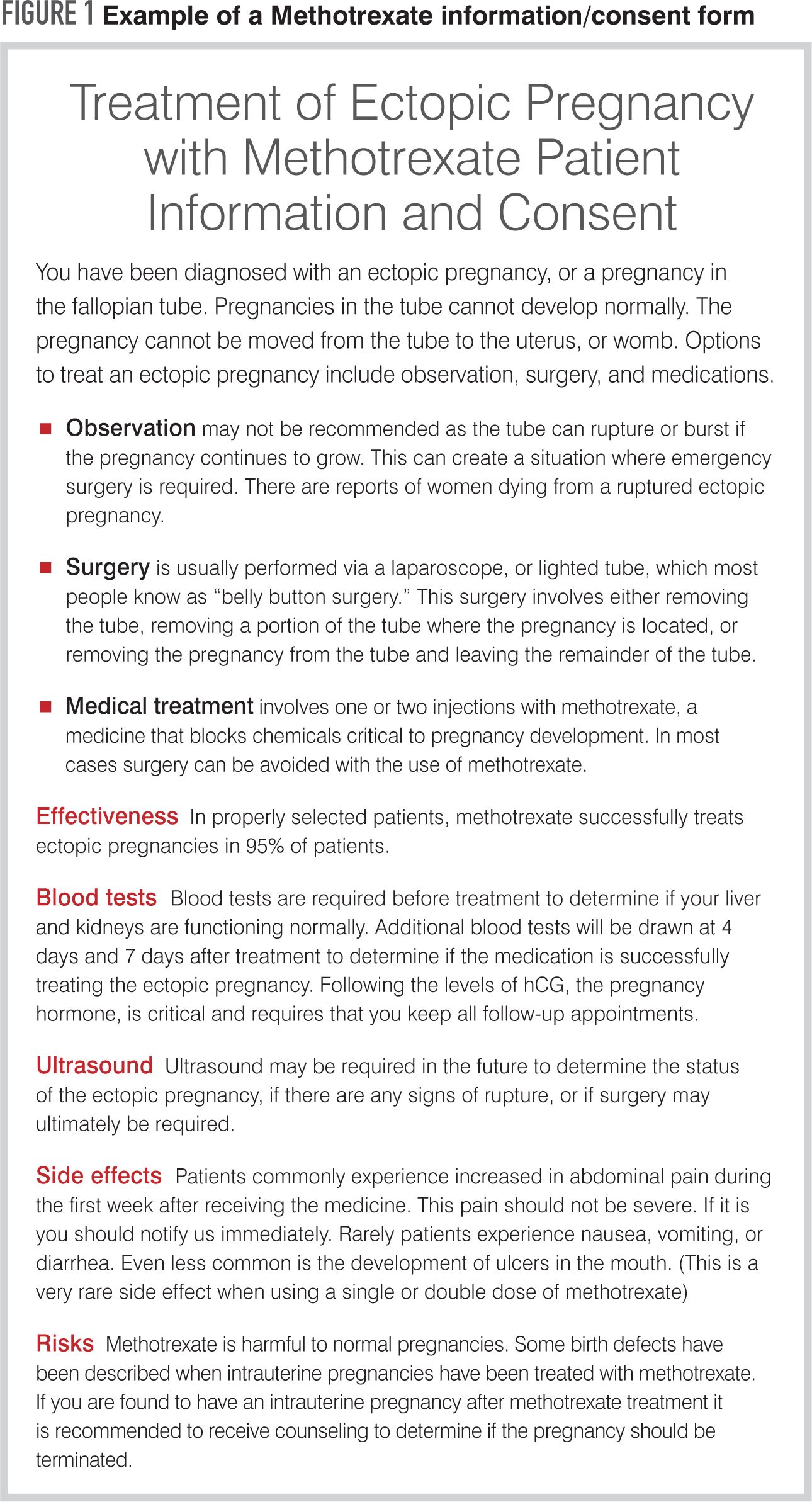IUP diagnosed and treated as ectopic: How bad can it get?
Misdiagnosis is not uncommon but when faced with a bad situation there are steps that an ob/gyn can take to limit the damages.

Figure 1

A 34-year-old G1P0 presented to the Emergency Department early in the morning with complaints of abdominal pain and vaginal bleeding. She underwent in vitro fertilization (IVF) approximately 2 weeks earlier. A quantitative hCG was 4,654 mIU/mL. An ultrasound was performed in radiology with the following interpretation: “Uterus normal sized with a thickened decidual reaction in the uterus. No fetal pole is identified. There is a moderate amount of fluid in the cul-de-sac. There is a right adnexal mass = 2.2 x 1.9 x 2.1 cm. These findings could be compatible with the presence of an ectopic. Clinical correlation and, if indicated, serial hCG levels and follow-up ultrasound studies should be considered.” The patient was clinically stable, with a hematocrit of 38.9%, her blood type was O positive and her liver function and kidney assessments were normal. After consulting with the patient’s gynecologist and after the patient signed a methotrexate (MTX) consent form, the patient was treated with methotrexate, 80 mg IM.
Blood hCG levels on Day 4 and Day 7 following methotrexate were 16,069 mIU/mL and 42,125 mIU/mL, respectively. An ultrasound at that time revealed a twin intrauterine pregnancy (IUP) with two yolk sacs and possible cardiac activity, consistent with 5 weeks’ gestation. An ultrasound performed 2 weeks later revealed a twin IUP with two yolk sacs, two fetuses, both with cardiac activity, consistent with 7 weeks’ gestation. The patient was referred to a maternal fetal medicine (MFM) subspecialist for counseling re: risks of fetal anomalies associated with MTX.
The patient was advised that risks of MTX were very low and fetal anomalies associated with MTX can be seen on ultrasound. The MFM recommended serial ultrasounds and offered reassurance. An ultrasound at 16 weeks revealed normally developing twin fetuses, with no observed anomalies. Due to a change in the insurance’s physician panel, the patient saw another MFM at 26 weeks’ gestation. This ultrasound revealed shortened limbs and small chins in both fetuses, with one having echogenic bowel and the other having a two-vessel cord. This MFM’s genetic counselor counseled the patient regarding the potential risk of MTX exposure and the potential fetal anomalies associated with such exposure.
The patient was counseled about the ultrasound findings in her babies and was offered the option of termination, although this would need to be performed in another state, due to the gestational age of the pregnancy. The patient elected to continue the pregnancy. The patient delivered at 38 weeks’ gestation by cesarean. The babies had hypotonia, micrognathia, short limbs, and dysmorphic facies. Ultimately, the babies had feeding difficulties and significant growth and developmental delays.
A suit was filed against the following physicians:
- The radiologist for missed diagnosis and misinterpretation of the images
- The consulting gynecologist/reproductive endocrinologist (REI) who not only ordered the MTX, but had performed the patient’s IVF, for misdiagnosis of the patient’s IUP, negligent use of methotrexate, and wrongful birth (allowed in this jurisdiction or state), which is a cause of action on behalf of the parents of a child or children with abnormalities that, had the parents known, they would have either terminated the pregnancy or avoided conception altogether, and
- The first MFM subspecialist for negligent counseling and wrongful birth.
The second MFM was not sued and was ultimately subpoenaed as a fact witness (merely reading the notes from his office chart) for the plaintiff.
The defense attorney had difficulty finding a defense expert, finally identifying an ob/gyn willing to testify on behalf of the physicians. However, several reviewing physicians made recommendations for settlement, as they identified several breaches of the standard of care, and to limit potential damages. The defendant physicians were insured by the same malpractice company that, to reduce frivolous lawsuits, had adopted a policy of taking every case to trial rather than settle.
The case went to trial with the following pertinent testimony:
The plaintiff’s expert testified that, with a history of IVF, a twin gestation was more likely. Thus, high levels of hCG without a demonstrable IUP is not uncommon. The patient was stable, thus immediate intervention was unnecessary. If follow-up hCG levels and ultrasounds had been obtained, the correct diagnosis of an intrauterine twin gestation would have been made. Further, MTX was the proximate cause of the observed fetal anomalies. The REI was negligent in administering MTX without a definitive diagnosis, and the MFM was negligent in providing inadequate and inaccurate counseling as to the risks of MTX. Had the patient been appropriately counseled early in the gestation, she would have terminated the pregnancy.
The defense expert testified that use of MTX for treatment of suspected ectopic pregnancy is within the standard of care. Risk of fetal anomalies with MTX is low and the patient received appropriate counseling and signed a written consent for use of the drug (see Figure 1 for example). A geneticist testifying for the defense reviewed the anomalies associated with MTX use, emphasizing that risk of pregnancy loss was greatest when given very early in pregnancy, while risk of fetal anomalies was greatest if MTX was given at 6 to 10 weeks’ estimated gestation, not when it was given in these patients.
A plaintiff dysmorphologist testified as to the potential fetal abnormalities associated with MTX, and correlated the abnormalities found in the twins and those associated with MTX use.
The defense then stated that the patient had a normal ultrasound at 16 weeks’ gestation and because the pregnancy was highly desired, would not have terminated it when anomalies were identified at 26 weeks’ gestation. Alternatively, the patient could have still terminated her pregnancy (although not in this state) at 26 weeks’ gestation. Further, she signed and consented to use of MTX.
The plaintiff testified she would have terminated had she known of the risks earlier in pregnancy. At the time the abnormalities were identified at 26 weeks, she ethically could not terminate the pregnancy. Finally, the plaintiff expert testified that, despite the signed MTX consent form, one cannot consent a patient to negligence.
Various life and actuarial experts for the plaintiff testified that the babies would likely live to 72 years of age, would require extensive, life-time support, and that the patients had suffered tremendous pain and suffering, a claim that had no caps in this state.
The jury came to the following verdicts:
- Radiologist: Defense verdict (not guilty)
- REI: Plaintiff verdict (guilty) for misdiagnosis of ectopic pregnancy/twin gestation and negligent use of MTX
- MFM: Plaintiff’s verdict (guilty) for negligent counseling and wrongful birth.
The jury recommended a total award of $73 million, including long-term support and therapy of two infants with anticipated life-span of 72 years and an award for pain and suffering for the parents. This jurisdiction (the state where the trial took place) recognizes joint and several liability, which means either guilty party can be liable for the entire judgment.
Fortunately, the defendant physicians, when being advised of the difficulty finding experts and the potential financial risk, consulted their own attorneys who asked, documented in writing, that the insurance carrier settle within the limits of the physicians’ policies, which was $2 million per case and $4 million cumulative for a year. The insurance company declined to settle. Thus, the malpractice carrier was responsible for the amount of the judgment that exceeded the physician’s limits, a total of $4 million, e.g. $69 million. The insurance company appealed to reduce the judgment. The outcome of the appeal was not published, as an out-of-court settlement on damages occurred.
Case analysis
This case highlights both medical and legal issues. Medically, misdiagnosis of an ectopic pregnancy as an IUP is not uncommon. Physicians must carefully assess such patients, preferably in person, and collate all available information, including the patient’s history, the laboratory and diagnostic studies, and the patient’s clinical status before reflexively administering MTX. Although the patient’s initial hCG level was greater than the published discriminatory levels, i.e. 3500 mIU/mL, the history of IVF placed the patient at greater risk for a multiple gestation, with resultant higher hCG levels than anticipated. Personally reviewing the ultrasound is recommended, as gynecologists are ultimately responsible for the patient outcome.
The order for the initial ultrasound did not include a history of IVF. Thus, the radiologist’s interpretation and recommendations were appropriate, based on the available information. Had the REI obtained serial hCG levels and ultrasounds, the correct diagnosis of a twin IUP would have been made. Diagnosis of an ectopic can only be definitively made if a gestational sac with a yolk sac and/or embryo is identified outside of the uterine cavity. Otherwise, the patient has either a non-definitive diagnosis or a pregnancy of unknown location. In such cases, if clinically stable, the patient should have serial hCG levels and repeat ultrasound for diagnosis. One rarely should make the diagnosis of an ectopic pregnancy at an initial visit unless the findings are definitive, that is, a gestational sac with yolk sac and/or presence of an embryo, with or without cardiac activity, outside of the uterus.
The defense attorney later learned that the first MFM had never offered termination to a patient, thus potentially imposing his beliefs against pregnancy termination on this patient, crossing an appropriate barrier in provision of care. Ob/gyns should review the available options with patients, allowing them to make an informed decision regarding their care, without allowing personally beliefs to hinder appropriate counseling. Patients can be referred to other providers if they elect a treatment course that conflicts with an ob/gyn’s personal beliefs and prevents providing such care to the patient.
Many physicians want insurance companies to fight every case, ostensibly to reduce frivolous suits. However, refusing to settle legitimate cases can have unexpected and devastating consequences, as illustrated here. Obtaining outside council was critical for the involved physicians. They received advice to settle the case. Having their own attorneys write a letter to the malpractice carrier to settle within the limits of their policies limited their financial exposure. If a settlement offer had been made and refused, the physicians may still have been liable for the judgment. However, the fact that the insurer refused to offer a settlement transferred the major financial risk to the malpractice carrier.
S1E4: Dr. Kristina Adams-Waldorf: Pandemics, pathogens and perseverance
July 16th 2020This episode of Pap Talk by Contemporary OB/GYN features an interview with Dr. Kristina Adams-Waldorf, Professor in the Department of Obstetrics and Gynecology and Adjunct Professor in Global Health at the University of Washington (UW) School of Medicine in Seattle.
Listen
Unveiling the complexities of preterm birth risk from nativity, ethnicity, and race
March 22nd 2024A recent study dissected the relationships between maternal nativity, ethnicity, and race in influencing preterm birth rates, shedding light on disparities and suggesting avenues for future research.
Read More
Study reveals link between opioid dosage and spontaneous preterm birth risk
February 21st 2024Recent research highlighted an association between the total dose of prescribed opioids during pregnancy and the heightened risk of spontaneous preterm birth, emphasizing the need for judicious opioid use in pain management for expectant mothers.
Read More
